
Some theorists have posited that stories are all about problem-solving. And certainly – as we have seen – problems are at the very core of story. So by giving the audience a chance to vicariously experience protagonists dealing with problems, a story is in effect a sort of playground or simulation where we can experience what potential problems and solutions feel like – but without any real-life consequences.
An important consideration here is cause and effect. In real life, what we experience has so many causes that it is well-nigh impossible to accurately pinpoint them all. We constantly feel the effects, but it’s hard to pinpoint all the causes. Nonetheless, we really like to have explanations for what’s going on, it gives us a greater sense of control over our own lives. As a species, we seek agency, we’re always looking for what caused something to happen, for the why behind things being as they are. We find it very confusing when we don’t know the reason for the events we live through, and we build elaborate mental constructs to explain to ourselves the world as we perceive it. In this context, we sometimes speak of “narratives”.
In stories, every scene must be the result of a preceding plot event. As we have said before, in between each plot event of a narrative you should be able to place the words not “and then”, but “because of that …”. (more…)

A story has a beginning, a middle, and an end. How to avoid the ‘saggy middle’.
The middle bit of a story is really the story proper. It is usually the longest section. It comes after the introduction of the main character(s) and the setting up of the context, that is the world of the story, as well as the problems and themes the story deals with.
At the end of the first section – prior to what we’re here calling ‘the middle bit’ –, the protagonist has decided to set off on the story journey. Obviously, this does not have to be physical journey through a particular geography, but it does mean that the main character is somehow entering into new and unfamiliar terrain. In this sense, every story is a ‘fish out of water’ story. The heroine must leave the comfort zone in order for the audience to feel interest in her plight.
Some authors jump right into this unfamiliar territory, showing the run up to it in flashbacks. Anita Brookner’s heroine Edith Hope has already arrived in the Hotel du Lac in the first sentence of the novel. Gradually the reasons for her stay here are revealed as the reader progresses through the novel.
Nonetheless, for an author, it may be advisable to create a marked threshold where the protagonist enters into the alien territory of the middle bit. The exploration and transversal of this territory is what on a plot level the middle bit is about, and it takes up the greater part of the story journey. (more…)

Nothing should be more important to an author than how their story makes the audience feel.
As an author, consider carefully the emotional journey of the reader or viewer as they progress through your narrative.
The audience experiences a sequence of emotions when engaged in a narrative. So narrative structure is a vital aspect of storytelling. The story should be touching the audience emotionally during every scene. Furthermore, each new scene should evoke a new feeling in order to remain fresh and surprising.
The author’s job is to make the audience feel empathy with the characters quickly, so that an emotional response to the characters’ situation is possible. Only this can lead to physical reactions like accelerated heartbeat when the story gets exciting. We have to care.
This “capturing” of the audience, making the reader or viewer rapt and enthralled, requires authors to create events that will show who the characters are and how they react to the problems they must face. The audience is more likely to feel with the characters as the plot unfolds when the characters’ reactions to events reveal something about who they really are – and how they might be similar to us.
One Journey to Spellbind Them All
Here we present a loose pattern that we think probably fits for any type of story, whatever genre or medium, however “literary” or “commercial”. It’s not prescriptive, just a rough checklist of the stages in the emotional journey the audience tacitly expects when they let themselves in on a story. The emotions are in more or less the order they might be evoked by any narrative.
Curiosity
(more…)

A blurb is a short text on the back of a paperback book designed to get you to purchase that book.
Received wisdom in the publishing industry has it that the cover design triggers browsing bookshoppers to pick up a particular book from the table, after which most people will turn it over to read what’s on the back. The short text on the back cover must then arouse so much interest about the content of the book that the impulse to purchase is triggered. Many customers might glance into the book first before actually going to the checkout.
The blurb text is also used to advertise the book in some print magazines and online shopping platforms. Again, the cover is likely to determine whether the blurb text gets read, but in most cases a sale is unlikely without the blurb having done its job of persuading the prospective customer that this is the right book for them.
Films also have blurbs, which are usually placed in combination with the film poster or a film still.
A blurb is therefore a marketing text. It is not a brief synopsis of the story! The blurb is not really designed to provide information, but to create interest. So the job of the blurb is actually to give just enough information to make withholding more information effective. Not saying quite as much as the recipient wants to know is how to arouse curiosity.
What this often boils down to is answering three key questions about the story in the blurb: (more…)

A synopsis is a summary of your story intended to be read by industry professionals.
This makes it a different text from a blurb, which is designed to be read by the public.
In both cases, you probably want the reader to purchase your story. But the reader of the blurb is merely buying a book or a movie ticket. The reader of the synopsis is taking a much greater risk if they decide to invest in your story.
An editor or publisher or a movie producer or director is accustomed to hearing story pitches. They want to find out as quickly as possible if your story is something that they might be interest in. So they need certain questions answered fast. These questions usually concern the premise(more…)
In recent years, scientists have been writing books about the reasons why we tell each other stories.

Neurobiologists have discovered that when a person is immersed in a story, their brain patterns are similar to what they would be if that person were actually performing the actions they are reading about or watching. So if a recipient is emotionally engaged in a story, they are essentially “living” it – at least in terms of the brain patterns. The excitement is real, the fear, the empathy, the arousal. See Boyd, 2009, or Gottschall, 2012*.
Simulation
This has given rise to the analogy of the flight simulator.
Stories are everywhere. We create and consume them from an early age. Homo sapiens have done so for millennia – our modern media are a result of our ancient need for stories. We have been telling them to each other ever since we, as a species, have been human. It’s what homo sapiens do. It’s a defining characteristic. What evolutionary biologists call an “adaptation”.
That means there is a reason for us to tell stories: They help us survive. (more…)
How narrative structure turns a story into an emotional experience.
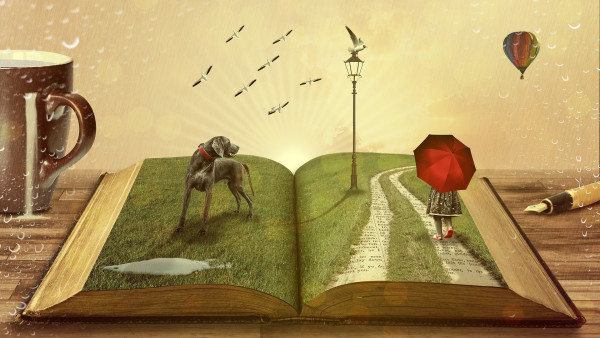
Image: Comfreak, Pixabay
Storytelling is a bit of an overused buzzword. While we are all – by dint of being human – storytellers, how aware are you of the principles of dramaturgy? What exactly constitutes a story, in comparison to, say, a report or an anecdote?
And just to be clear, the following is not a story. It’s an how-to article.
Whatever the medium – film or text, online or offline –, storytelling has something to do with emotionally engaging an audience, that much seems clear. So is a picture of a cute puppy a story? Hardly.
Stories exist in order to create a difference in their audience. Stories always address problems and tend to convey the benefits of co-operative behaviour.
While there simply is no blueprint to how stories work, let’s examine the elements that recur in stories and try to find some patterns.
Who is the story about?
All stories are about someone. That someone does not have to be a person, it can be an animal (Bambi) or a robot (Wall-e). But a story needs a character. In fact, all stories have more than one character, with virtually no exceptions. This is because the interaction between several characters provides motivation, conflict and action.
Moreover, stories usually have a main character, the figure that the story seems to be principally about – the protagonist. It is not always obvious why one character is the protagonist rather than another. Is she simply the most heroic? Is she the one that develops most? Or does she just have the most scenes?(more…)

Author and creative writing teacher Jesse Falzoi was born in Hamburg and raised in Lübeck, Germany. Back in the nineties, after stays in the USA and France, she moved to Berlin, where she still lives with her three children.
She has translated Donald Barthelme stories into German. Her own stories have appeared in American, Russian, Indian, German, Swiss, Irish, British and Canadian magazines and anthologies. She holds an MFA in Creative Writing from Sierra Nevada College.
Her new book on Creative Writing is released end of May 2017.
At the age of twenty-one I quit university and bought a one-way ticket to San Francisco, USA. I wanted to get far away from my first attempts to grow up. I wanted to get away from a frustrating relationship and boring courses and everything that was pushing me to take life more seriously. I didn’t have any plans what I would be doing in San Francisco but I had the address of an acquaintance I had made a year before. I went on a journey that was physical in the beginning and became more and more spiritual during the process. I bought a return ticket in the end and went back to my hometown just to pack my suitcases for good; I’d be staying in Germany, but I wouldn’t be staying home.
(more…)
The logline is probably the hardest sentence to write.
The logline sums up a story in one sentence. This sentence should be memorable and clear, which means it is unlikely to be much longer than thirty words or to have complex syntax.
Once your reader has read your logline – or your listener heard it –, they will ideally know the following about your story:
- who it is about
- what the central conflict or main problem is
- what the most important characters do in the story
- why they do it, i.e. what their motivations are
- how they do it
- where all this happens, i.e. what the setting is
- when it happens, i.e. what the period is
The first of these points even counts double – since usually the logline should convey not only who the main protagonist is, but also what antagonism she faces.
What’s the logline for?
The purpose of the logline is to pitch your story.(more…)

Conflict is the Lifeblood of Story.
In real life, conflict is something we generally want to avoid. Stories, on the other hand, require conflict. This discrepancy is an indicator of the underlying purpose of stories as a kind of training ground, a place where we learn to deal with conflict without having to suffer real-life consequences.
In this post we will look at:
- An Analogy
- Archetypal conflict in stories
- Conflict between characters
- Conflict within a character
- The central conflict
Along with language (in some form or other, be it as text or as the language of a medium, such as film) and meaning (intended by the author or understood by the recipient), characters and plot form the constituent parts of story. It is impossible to create a story that does not include these four components – even if the characters are one-dimensional and the plot has no structure. However, it is formally possible to compose a story with no conflict.
It just won’t be very interesting.
In terms of narrative, conflict is presented as a series of confrontations of increasing intensity. If there are no confrontations – no battles of wits or fists, no crossing of swords or sparring with words – there is little to hold the audience’ attention. To create confrontations, there must be at least a of conflict of interest between the characters.
Conflict does not occur at particular points in a story. It permeates the whole of it. It expresses the values transported by the story’s theme. It creates at least two options of choice, both of which must appear to some extent reasonable and justifiable to the protagonist, particularly at the moment of crisis.
(more…)
In stories, characters are faced with obstacles.
These obstacles come in various forms and degrees of magnitude. And they may have different dimensions: they may be internal, external, or antagonistic.
Often the obstacles that resound most with a significant proportion of the audience are the ones that force the main characters to face and deal with problems within themselves, in their nature. In other words, with their internal problem.
Internal obstacles are the symptoms of the characters’ flaws or shortcomings, i.e. of the internal problem. The audience perceives them in scenes in which the character’s flaw prevents her progress.
Not every story features characters with internal problems. An internal problem is not strictly speaking necessary in order to create an exciting story.
But it helps.
The Emotional Truth
An internal problem makes the character appear fallible – and thus more credible, more human, more like us. Internal problems are invariably emotional and private. They express(more…)
You’re on a boat, and you see somebody fall into the water. Which of the following two cases would cause you to react with stronger emotion?
- The water is four feet deep and you know that the guy who fell in is a good swimmer
- The water is four feet deep and the person who fell in is a three year old girl who can’t swim
Presumably your emotional reaction would be stronger if the child fell off the boat. Because you know that the child’s life is at stake. The first situation is not life-threatening, the only thing at stake is the dryness of the man’s clothes and his self-esteem.
The degree you care about events that happen to people, and to yourself, is directly related to what’s at stake. This applies as much to fictional characters as in the real world.
Hence it is immensely important for storytellers to(more…)
In a story, if the treasure is what the hero wants, then slaying the dragon is the goal.
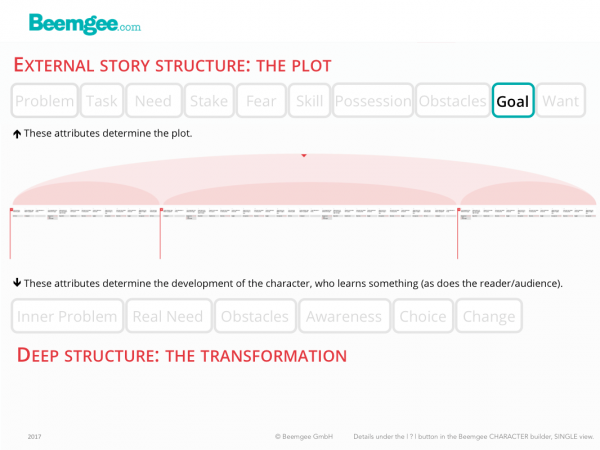
The goal is what the character thinks will lead to the (satisfaction of the) want.
Since the treasure hoard has been there for ages, there must usually be some sort of trigger for the story to get started, i.e. for the character to want the hoard now, at the time the story begins. Often, an external problem creates such a trigger. It might supply a reason why the hero needs the hoard now, something more specific than just the general sense of wanting to be rich. Perhaps the hoard isn’t the reason at all. Perhaps there is a princess in distress, which certainly adds urgency to the matter. Either way, dealing with the dragon is the goal.
If somebody says the word “goal” to you, the image that springs to mind might have to do with the ends of a football pitch. The(more…)
Stories are about people who want something.
We can distinguish between two different types of want:
- the wish, or character want
- the plot want
Marty McFly wishes to be a musician (character want). He also wants to get Back to the Future (plot want).
The wish or character want is a device which adds cohesion to the story, usually in the form of the set-up/pay-off. Marty is seen at the beginning of the film practicing the guitar; at the end of the film he plays at a concert. A character-inherent wish is a useful technique to make the character clearer to the audience, but it is not essential to composing a story.
Indispensable is what we have called the plot want. As a result of the external problem – the trigger event that sparks the chain of cause and effect which the bulk of the plot consists of –, the character feels an urge, which provides the motivation for the character’s actions in the story.
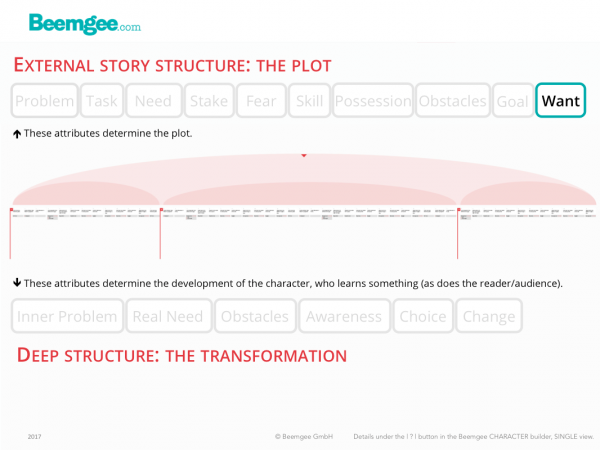
The want is the state for which the character strives, and is distinct from the goal.
In this post we’ll be talking about active vs. passive characters, motivation, the difference between a want and a goal, a couple of writer traps to avoid, and contradictory wants.
Active Characters
Characters have to be actively acting of their own volition. The want has to be urgent and strong enough for them to do things. If the want is missing or too weak, the character will lack motivation and appear passive. A passive character is usually not interesting enough to hold the audience’ or readers’ attention.
Why is this so?
Evolutionary explanations of stories attempt to shed light on the phenomenon. When characters react to events rather than cause them, they appear weak, as victims in a chaotic, uncontrolled world. Which means that there is not much we can learn from them. Humans try to see cause and effect in everything, not just in stories. And humans experience stories physically and emotionally (our hearts beat faster, our palms sweat), so there is really not much difference between how we experience a story and real life. Since we learn from experience, we instinctively prefer stories which provide us with experiences that benefit us in some way. In stories we vicariously experience or practice primarily social problem-solving, without suffering real-life consequences. We tend to learn more when we experience stories of self-motivated problem-solving.
Motivation
There is a good reason for that cliché about actors always asking about their motivation. It is motivation that prompts the characters in a story to do the things they do. Stories seem to work best not only when characters are active rather than passive, but often when they have comprehensible reasons for their activity.
The reason for what a character wants is usually comprehensible for the audience or reader because of the external problem. In simple terms, the character wants to solve the problem. Take the Cinderella story as an example. Her problem is that she is bound to the stepmother and her two nasty daughters.
In other words, the want is a vision the character has of his or her situation without the problem. Hence what the character wants is actually a particular state of being. Such a state might mean being in a position of wealth, power or respect, or being in a happily ever after relationship. Cinderella wants merely to be free of her involuntary servitude, if only for a little while.
This makes the want distinct from the goal, which is the specific gateway to the wanted state of being, as perceived by the character. A story usually sets up a goal the character needs to reach or attain in order to achieve the want. In Cinderella’s case, it is attending the ball.
So, a story has its characters pursue their wants. These different wants oppose each other, causing conflicts of interest. The conflicting wants make the characters active, and the audience/readers like stories about actions, that is, about characters who do things.
Sounds simple.
And yet frequently stories seem to mess up on this vital point.
Next to passive characters without a strong enough want, lack of clear motivation is a huge writer trap. It is possible to write a whole story full of characters who are reactive instead of active, or who do things of their own volition but without that volition being clearly recognisable to the audience/reader. It is perhaps even tempting to write stories like that, because they seem more lifelike. In real life, people do not necessarily have distinct goals. Often, our wants are vague and not clearly definable. What about writing a realistic story about a character with a general sense of dissatisfaction, who, like so many of us, has lost sight of any clear objective in life?
It’s doable, certainly. But the audience/readers will probably start to look for the specific want of such a character. They would probably begin to expect the story to be about this character’s search for a clear objective in life. That might be the want the audience would tacitly ascribe to the character.
And if the story does not bear such motivation out, the risk is significant. Because stories in which the audience does not understand what the characters want lack emotional impact.
Contradictory Wants
A way of adding psychological depth and emotional complexity to characters is to give them several and even contradictory wants. Gollum in Lord Of The Rings wants the ring. Yet a part of him also wants to give up the ring and help Frodo. Next to solving the case, Marty Hart in True Detective wants to be a good husband and family man, but he also wants affairs with other women. That’s three wants for one character.
A want is not merely a yearning, it is an expression of values. What a character desires shows the audience something about that character. In this sense, two contradictory wants provide the basis for a powerful scene of choice. At a crisis point, the character may face a dilemma and have to choose between two courses. Both might lead to some state the character desires, but these desires prove to be mutually exclusive. For the audience, which choice is the right one might be obvious – they will be rooting for the character to go one way. But for the character there may be a strong pull the other way. The final choice shows the character’s moral fibre – and often expresses the story’s theme.
When not to want
Is it really always absolutely necessary for every character to have a clearly defined want?
Not entirely. Because, of course, there are exceptions.
In certain cases, the author might deliberately obfuscate the why of a character’s actions in order to inject mystery. Not knowing something keeps the audience/reader guessing and turning the pages or not switching the channel. Usually this mystery is cleared up at some point. The audience tends to expect that. Which implies that even if the want was not made clear to the audience early in the story, it was there in the character nonetheless – and certainly the author was aware of it.
Injecting mystery by keeping character motivations hidden is not in itself a writer trap. But nearly. When tempted to use such a device, an author should at least consider if it would not actually be more interesting for the audience to know the character’s motivation.
Having said that, there are rare cases where a character’s motivation does remain unexplained. And those cases can be powerful. Especially when it’s a baddy we don’t understand.
Think of Iago in Shakespeare’s Othello, who is simply bad to the bone and we’ll never really know why. Shakespeare – deliberately, one presumes – gives no hint as to what Iago hopes to achieve by ruining Othello. Shakespeare might easily have given Iago some clearly understandable motivation, such as revenge of a past wrong, envy of Othello’s success, desire to usurp Othello’s position, lust for Desdemona. But he didn’t. And Iago is one of the most superb villains ever.
Another possible exception are (fiction) memoirs in the first person, such as David Copperfield, The Catcher in the Rye, Saul Bellow’s The Adventures of Augie March, or William Boyd’s Any Human Heart. In such stories, the effect of the narrator telling his or her own story creates a disparity between the time of the story told and the implicit future time of the act of telling. The narrator is relating a past from the perspective of an older self. This older self has reached a state of being which is different from that of the character being told about – the narrator is wiser than his or her younger self. This creates an effect for the reader: the reader wants to know how the character reach this older, wiser state. With this device, it is possible to make character wants less obvious or direct and still maintain an emotional drive to the story.
Perhaps the most interesting thing about a character’s want is how it stands in conflict with what that character really needs.
Related function in the Beemgee story development tool:
Character Developer
Click to open a new story project:
In storytelling, a McGuffin (or MacGuffin) is something that the protagonist is after – along with most other characters in the story.
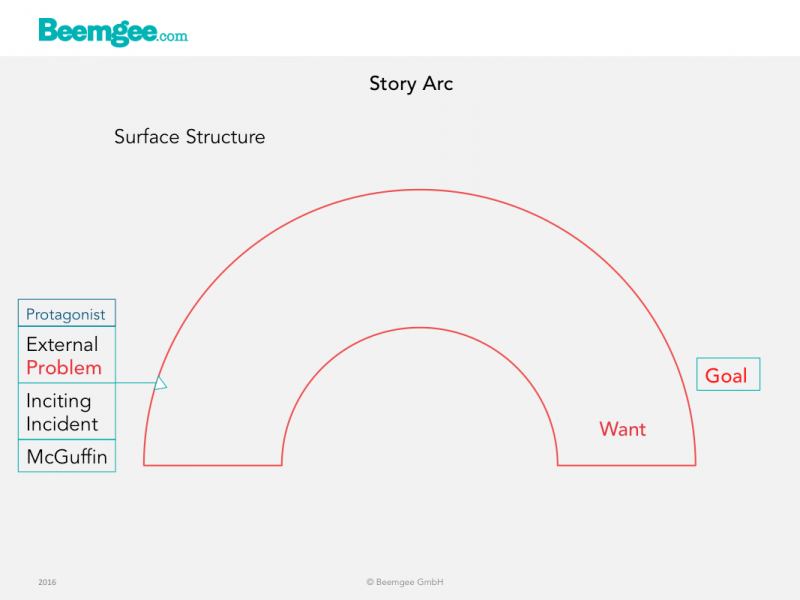
The use of a McGuffin is a device the author employs in order to give a story direction and drive.
Easy to spot McGuffins are the Ark of the Covenant in Raiders Of The Lost Ark, the statuette in The Maltese Falcon, private Ryan in Saving Private Ryan, the ring (more specifically, the act of its destruction) in Lord Of The Rings. Note how in these examples, the McGuffin is in the title of the story. The McGuffin is embedded in the narrative structure and becomes what the story is about, on the surface at least.
Typical genres that have McGuffins are comedy, crime, adventure, fantasy and other quest stories. But conceivably, a dressed up McGuffin might be found in any genre.
Nor does a McGuffin have to be an object. It could be a person or a quality. In a story of several characters vying for the love of one other character, that love might be considered the McGuffin. A place might become a McGuffin too – consider the role of the planet Earth in Battlestar Galactica.
In terms of narrative structure, a McGuffin occupies the(more…)
If there is one thing that ALL stories have in common, it is change.
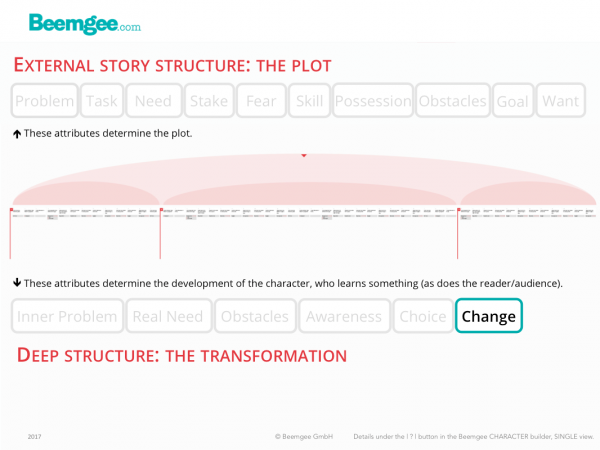
A story, pretty much by definition, describes a change. Indeed, every single scene does.
Within a story, what changes?
At the very least,
- one of the characters, usually the protagonist
- often other characters too
- sometimes the whole story-world
- who understands what – the perception of what is true or valuable
1 – The protagonist changes
We have said before that a protagonist is usually wiser at the end of the story than at the beginning. We have seen that this has something to do with the want, which – whether the character achieves it or not – is usually only attainable by causing a change. Often the change involves the character’s solving the internal problem, so the change takes place within the character. This involves the recognition of the necessity for change, i.e. the acceptance of the real need, and the struggle to achieve it. So all the incidents and events in the plot, the hindrances and obstacles the characters deal with, are in themselves not so very interesting. What interests the audience more is how these events and obstacles change the character.
Having said that, a story may well show no more change than the solving of an external problem. A story world is disturbed, but at the end returns to a similar state. For instance in a detective story, where the crime is solved but the protagonist does not really develop.
2 – Several characters change
Characters don’t change in a vacuum. They learn through interactions with each other. Relationships cause change. In many stories, subplots will tell of the characters that surround the protagonist, and their changes and developments may well cast light on various aspects of the story’s theme. Or perhaps the story is an ensemble piece, where it is not easy (or even necessary) to identify a main protagonist. Or it is a romance, or buddy-story, which apparently has two main characters. Whichever – some level of change usually occurs in all the main characters as a result of how they interact with each other.
There is, by the way, one often neglected archetype who also typically changes. This role is sometimes referred to as foil. We call it the role of the contrastor. The contrastor mirrors and contrasts the protagonist, like Han Solo to Luke Skywalker in Star Wars or the mother to the boy in Boyhood.
3 – The whole world changes
Quite possibly, the entire story-world may be different by the end of the story than it was at the beginning. Story-world as a concept refers to the scope of the world presented in the story, so if the field of action of the characters is small, the story-world is small too. If the story is an epic, the story-world will be big, a version of an entire world.
As an aside on this last point, consider the classical genres. Epics – again, almost by definition – describe a change in a whole world. In a way, so does tragedy, for at the end of the tragedy the world will have lost one or more of its population, since tragedy deals with the change from life to death.
Comedy seeks to describe a different fundamental change in the story-world. The typical structure of comedy, whether we are talking about Aristophanes or modern TV sitcoms, has a stable situation at the beginning which is disturbed by some event or problem. The disturbance causes first a lot of messy but generally non-life-threatening chaos which is resolved by a return to the original undisturbed situation. Even if the main characters end up married, for example, the story-world is brought back to its stable state.
The very serious point of comedy is to demonstrate a fundamental truth: the cyclical nature of change in the universe. Spring always returns, no matter how bleak the winter. Day always comes, no matter how dark the night. Change does not have to be final. Change can be cyclical. Change is life.
4 – The Perception of Truth
The most fundamental change that stories tend to describe is one of recognition of truth. What is not known at the beginning of the story is recognised and thus becomes known at the end. This is obvious in crime stories, but holds true for almost all other stories too. The story therefore amounts to an act of learning. Often the learning curve is observable in the protagonist, who tends to be wiser at the end than at the beginning.
But the point is really that the recipient, the reader or viewer, is actually the one doing the learning – through experiencing the story.
The audience changes.
At least, that’s the general idea. The story provides a physical, emotional and intellectual experience – physical when your heart beats faster or your palms sweat, emotional when you feel for the characters, and perhaps intellectual too if the story gives you pause for thought. If the story achieves none of these responses, then it has failed. An experience, again pretty much by definition, changes you. We learn through experience; so if you have changed, chances are it’s because you have learnt something.
Hence it is not only within the story that a change takes place. It takes place outside of the story as well, in the recipient.
Within some stories one may argue that no real change occurs – Alice does not obviously change due to her experience in Wonderland. But the reader has been taken on a wild journey, and the experience is likely to have left some sort of mark.
How does a story provide an experience?
By allowing the recipient, the audience or reader, to understand and feel change and transformation throughout the story. Every scene describes a change. The entire narrative shows a difference between the “before and after”. Stories have a tendency to symmetry: The beginning of the story makes clear what the state of the protagonist or the story world is before the story journey commences, and the end of the story has a corresponding scene or event that shows what the state is after.
For the author, then, the task is to clearly know the state of things for the protagonist, the cast of characters, the story world, and the audience at the end of the tale, and the state of things at the beginning of the tale. The greater the contrast, the better. Once these two points of reference are known, the author works out the many steps needed to get the protagonist, the cast of characters, the story world, and the audience from one state to the other.
There is a paradox here. The change that occurs is also an expression of new equilibrium. At a very basic level, story structure can be described as follows:
- an external problem (a change in the ordinary world of the protagonist) disturbs the equilibrium of the initial situation
- the disturbance is explored, a struggle ensues in which obstacles must be overcome
- the problem is understood and dealt with, creating a new equilibrium or resolution
So change is all-pervasive in stories, within them in the form of character development, and without in the form of audience understanding. And that is not even to consider the transformational power of telling a story, when the act of telling the story brings about change in the author.
Read here how change is important for every single scene, though we prefer to call them plot events.
Related function in the Beemgee story development tool:
Character Developer
Not developing your story yet? Click here:
A character with a goal needs to do something in order to reach it.
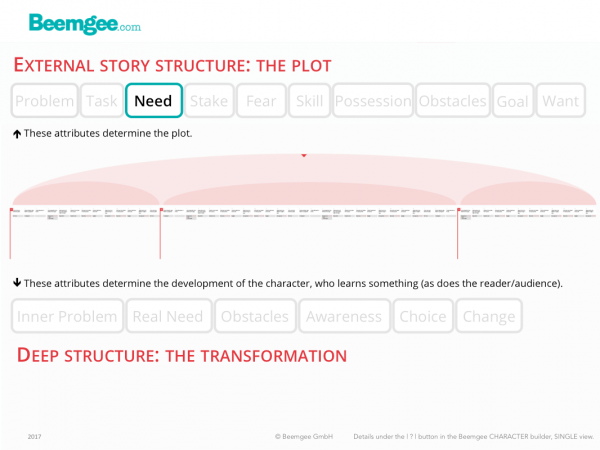
The outward needs of a character – things she needs to acquire or achieve in order to reach the goal – divide the story journey into stages.
In storytelling, characters usually know they have a problem and there is usually something they want. They tend to set themselves a goal which they believe will solve their problem and get them what they want.
In order to get to the goal, the character will need something. Some examples: If the goal is a place, a means of transportation is necessary to get there. If we can’t rob the bank alone, we’ll have to persuade some allies to join our heist. If the goal is defeating a dragon, then some weapons would be helpful. If magic is needed, we’ll have to visit the magician to pick some up.
While the perceived need might be an object or a person, it usually requires an action. We’ll need a car, so do we buy one or steal one? We’ll need a sword, so do we pull one out of a stone or go to the blacksmith? If we need help, who do we ask and how do we talk them into joining us? We’ll need magic, but how do we find a magician? Ask an elf or go to the oracle for advice?
So, once the goal is set, a vision of the way to reach it opens up to the protagonist – and with that to the audience/reader. At the very least, the first step of the way presents itself. All this is what the character is conscious of.
In other words, the character forms a plan.
The plan is communicated more or less explicitly to the audience. The anticipation of how things will not go quite according to plan is part of the pleasure. There must always be surprises in store for the characters as well as for the audience.
Stages and Obstacles
The perceived needs are (more…)
What’s the problem? Does the character know?
In storytelling, discrepancy between a character’s awareness and the awareness-levels of others is one of the most powerful devices an author can use. “Others” refers here not just to other characters, but to the narrator and – most significantly – to the audience/reader.
Let’s sum up potential differences in knowledge or awareness:
- A character’s awareness of his or her own internal problem or motivation
- A difference between one character’s knowledge of what’s going on and another’s
- The narrator knows more about what is going on than the character
- The audience/reader knows more than the character – dramatic irony
In this post, we’ll concentrate on the first point: Awareness of the internal problem. We’ll break that down into
- Becoming Aware – the importance of the revelation
- The Story Journey – and where to place the revelation
- Surface Structure and Deep Structure
- The Need for Awareness – or, Alternatives to Revelation
Becoming Aware – the importance of the revelation (more…)
An inner or internal problem is the chance for change.
While the external problem shows the audience the character’s motivation to act (he or she wants to solve the problem), it is the internal problem that gives the character depth.
In storytelling, the internal problem is a character’s weakness, flaw, lack, shortcoming, failure, dysfunction, error, miscalculation, unresolved issue, or mistake. It is often manifested to the audience through a negative character trait. Classically, this flaw may be one of excess, such as too much pride. Almost always, the internal problem involves egoism. By overcoming it, the character will be wiser at the end of the story than at the beginning. Thus the character must learn cooperative behaviour in order to be a mature, socially functioning person.
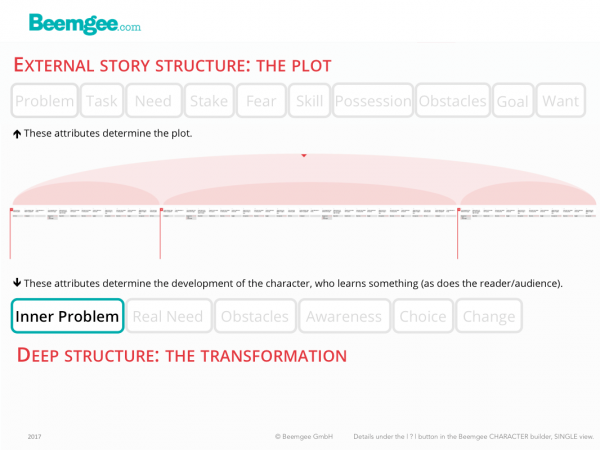
The inner problem is the pre-condition for the character’s transformation. It is the flaw, weakness, mistake, error, or deficit that needs to be fixed. In other words, it shows what the character needs to learn.
Internal problems may be character traits that cause harm or hurt to others. They cause anti-social behaviour. And internal problems can also harm the character. They can be detrimental to his or her solving the external problem.
From Lack of Awareness to Revelation
While the external problem provides a character’s want, i.e. motivation, the internal problem provides the need.
The audience sees the flaw before the character does. The character is blinkered, has a blind spot. She first has to learn to see what the audience already knows. (more…)
In stories, characters solve problems. This is the basic principle of story.
Problems come in all shapes and sizes. What’s more, in storytelling they come from within and without. The problems that come from within are hidden, internal, and it is quite possible for a character not to be aware of them. They are typically character flaws or shortcomings.
But they are not usually what gets the story going. Most stories begin with the protagonist being confronted with an external problem.
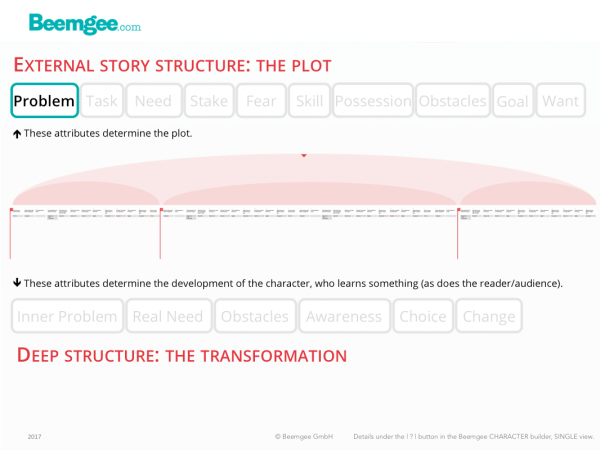
The external problem of the main character triggers the plot. It is shown to the audience as the incident which eventually incites the protagonist to action.
In some genres this is easy to see. In crime or mystery fiction, the external problem is almost by definition the crime or mystery that the protagonist has to deal with.(more…)
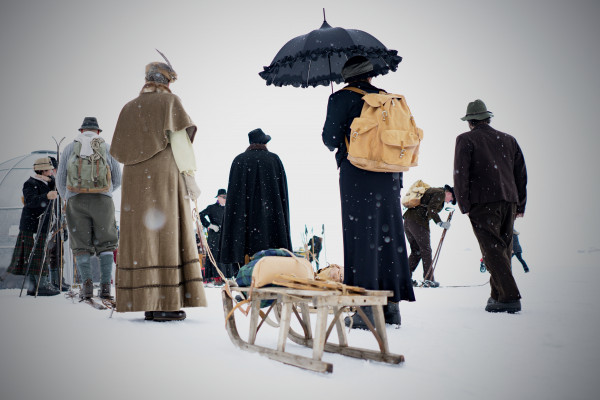
Stories are about people. Even the ones about robots, or rabbits, or whatever.
If you’re thinking about composing a story, you will probably have some characters in mind that will be performing the action of the story. In stories, action and actors (in the sense of someone who does something) are pretty much the same thing looked at from two differing perspectives, as we have noted in our post Plot vs. Character.
The most obvious difference between characters in stories and people in real life is that story characters tend to be driven. Narratives tend to be more compelling when the characters they describe are highly motivated. Rarely in life are our wants, goals, and perceived needs as clear and powerful as for characters in stories. Our real lives tend to drift rather than head in a specific direction; it is often in retrospect that we ascribe direction when we try to understand our lives by putting them into narratives. Historical personages who seem to demonstrate drive and direction (and have perhaps become historical personages because they had these qualities) make for more interesting biographies than people whose motivations were less strong.
Another aspect that sets characters in fiction apart from people in life is that characters tend to fulfil narrative functions in their story. People, on the other hand, live their lives by acting naturally according to the dictates of their personality. A story is a more or less enclosed unity, while an individual’s life is part of a greater whole. Only in retrospect do we sometimes overlay a narrative onto the biography of an individual – because we tend to feel happier when we perceive structure or direction in the lives of others or indeed our own. We can extract more meaning out of a life that can be told with structure and direction. In fact, there is no way of recounting a person’s biography without making choices concerning structure. If we’re honest, even the choice of which events to relate and how to relate them injects a fair amount of fiction into the story of a life, especially when that life is our own as we tell it to others or ourselves.
Many stories focus primarily on one protagonist. In fiction at least, the protagonist is often wiser at the end of the story than at the beginning. The(more…)


















